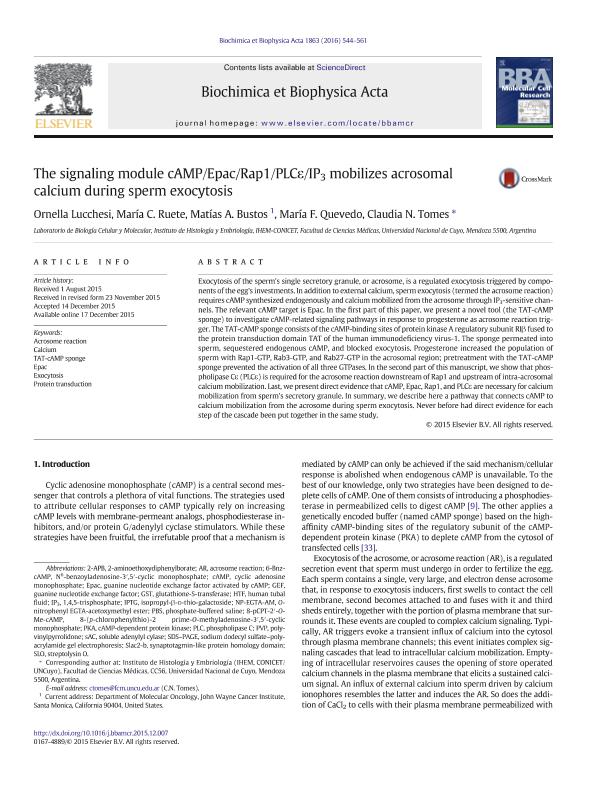Mostrar el registro sencillo del ítem
dc.contributor.author
Lucchesi, Ornella

dc.contributor.author
Ruete, María Celeste

dc.contributor.author
Bustos, Matias Alberto

dc.contributor.author
Quevedo, María Florencia

dc.contributor.author
Tomes, Claudia Nora

dc.date.available
2018-03-27T20:12:12Z
dc.date.issued
2016-04
dc.identifier.citation
Lucchesi, Ornella; Ruete, María Celeste; Bustos, Matias Alberto; Quevedo, María Florencia; Tomes, Claudia Nora; The signaling module cAMP/Epac/Rap1/PLCε/IP3 mobilizes acrosomal calcium during sperm exocytosis; Elsevier Science; Biochimica et Biophysica Acta-Molecular Cell Research; 1863; 4; 4-2016; 544-561
dc.identifier.issn
0167-4889
dc.identifier.uri
http://hdl.handle.net/11336/40232
dc.description.abstract
Exocytosis of the sperm's single secretory granule, or acrosome, is a regulated exocytosis triggered by components of the egg's investments. In addition to external calcium, sperm exocytosis (termed the acrosome reaction) requires cAMP synthesized endogenously and calcium mobilized from the acrosome through IP3-sensitive channels. The relevant cAMP target is Epac. In the first part of this paper, we present a novel tool (the TAT-cAMP sponge) to investigate cAMP-related signaling pathways in response to progesterone as acrosome reaction trigger. The TAT-cAMP sponge consists of the cAMP-binding sites of protein kinase A regulatory subunit RIβ fused to the protein transduction domain TAT of the human immunodeficiency virus-1. The sponge permeated into sperm, sequestered endogenous cAMP, and blocked exocytosis. Progesterone increased the population of sperm with Rap1-GTP, Rab3-GTP, and Rab27-GTP in the acrosomal region; pretreatment with the TAT-cAMP sponge prevented the activation of all three GTPases. In the second part of this manuscript, we show that phospholipase Cε (PLCε) is required for the acrosome reaction downstream of Rap1 and upstream of intra-acrosomal calcium mobilization. Last, we present direct evidence that cAMP, Epac, Rap1, and PLCε are necessary for calcium mobilization from sperm's secretory granule. In summary, we describe here a pathway that connects cAMP to calcium mobilization from the acrosome during sperm exocytosis. Never before had direct evidence for each step of the cascade been put together in the same study.
dc.format
application/pdf
dc.language.iso
eng
dc.publisher
Elsevier Science

dc.rights
info:eu-repo/semantics/openAccess
dc.rights.uri
https://creativecommons.org/licenses/by-nc-sa/2.5/ar/
dc.subject
Acrosome Reaction
dc.subject
Calcium
dc.subject
Epac
dc.subject
Exocytosis
dc.subject
Protein Transduction
dc.subject
Tat-Camp Sponge
dc.subject.classification
Otras Ciencias Biológicas

dc.subject.classification
Ciencias Biológicas

dc.subject.classification
CIENCIAS NATURALES Y EXACTAS

dc.title
The signaling module cAMP/Epac/Rap1/PLCε/IP3 mobilizes acrosomal calcium during sperm exocytosis
dc.type
info:eu-repo/semantics/article
dc.type
info:ar-repo/semantics/artículo
dc.type
info:eu-repo/semantics/publishedVersion
dc.date.updated
2018-03-27T13:35:39Z
dc.journal.volume
1863
dc.journal.number
4
dc.journal.pagination
544-561
dc.journal.pais
Países Bajos

dc.journal.ciudad
Amsterdam
dc.description.fil
Fil: Lucchesi, Ornella. Consejo Nacional de Investigaciones Científicas y Técnicas. Centro Científico Tecnológico Conicet - Mendoza. Instituto de Histología y Embriología de Mendoza Dr. Mario H. Burgos. Universidad Nacional de Cuyo. Facultad de Cienicas Médicas. Instituto de Histología y Embriología de Mendoza Dr. Mario H. Burgos; Argentina
dc.description.fil
Fil: Ruete, María Celeste. Consejo Nacional de Investigaciones Científicas y Técnicas. Centro Científico Tecnológico Conicet - Mendoza. Instituto de Histología y Embriología de Mendoza Dr. Mario H. Burgos. Universidad Nacional de Cuyo. Facultad de Cienicas Médicas. Instituto de Histología y Embriología de Mendoza Dr. Mario H. Burgos; Argentina
dc.description.fil
Fil: Bustos, Matias Alberto. Consejo Nacional de Investigaciones Científicas y Técnicas. Centro Científico Tecnológico Conicet - Mendoza. Instituto de Histología y Embriología de Mendoza Dr. Mario H. Burgos. Universidad Nacional de Cuyo. Facultad de Cienicas Médicas. Instituto de Histología y Embriología de Mendoza Dr. Mario H. Burgos; Argentina
dc.description.fil
Fil: Quevedo, María Florencia. Consejo Nacional de Investigaciones Científicas y Técnicas. Centro Científico Tecnológico Conicet - Mendoza. Instituto de Histología y Embriología de Mendoza Dr. Mario H. Burgos. Universidad Nacional de Cuyo. Facultad de Cienicas Médicas. Instituto de Histología y Embriología de Mendoza Dr. Mario H. Burgos; Argentina
dc.description.fil
Fil: Tomes, Claudia Nora. Consejo Nacional de Investigaciones Científicas y Técnicas. Centro Científico Tecnológico Conicet - Mendoza. Instituto de Histología y Embriología de Mendoza Dr. Mario H. Burgos. Universidad Nacional de Cuyo. Facultad de Cienicas Médicas. Instituto de Histología y Embriología de Mendoza Dr. Mario H. Burgos; Argentina
dc.journal.title
Biochimica et Biophysica Acta-Molecular Cell Research

dc.relation.alternativeid
info:eu-repo/semantics/altIdentifier/doi/http://dx.doi.org/10.1016/j.bbamcr.2015.12.007
dc.relation.alternativeid
info:eu-repo/semantics/altIdentifier/url/https://www.sciencedirect.com/science/article/pii/S0167488915004280
Archivos asociados
